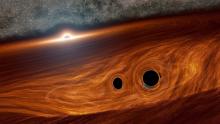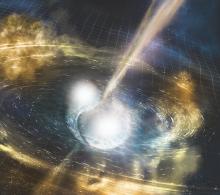Listen to today's episode of StarDate on the web the same day it airs in high-quality streaming audio without any extra ads or announcements. Choose a $8 one-month pass, or listen every day for a year for just $30.
You are here
Taking a Break
One of the most productive observatories of the century is taking a break. It’s being upgraded to make it more sensitive.
LIGO “listens” to the universe for gravitational waves — ripples in space and time caused by the motions of massive objects. Over the last five years, it’s recorded several dozen mergers by various combinations of black holes and neutron stars. These objects are so heavy that they whip up the space around them like a cosmic blender, producing huge amounts of gravitational waves. The waves reveal details about the objects that produce them, and about space itself.
But the waves are extremely weak, so they’re hard to catch. It took an amazing effort to design and build an observatory to find them.
LIGO consists of two facilities — one in Louisiana, the other in Washington State. Each consists of two “arms” aligned at a right angle to each other. The arms are two-and-a-half miles long. A laser beam shoots down the arms and reflects back and forth off mirrors at each end. If a gravitational wave passes by, the length of one of the arms changes by as little as one ten-thousandth the width of a proton, which the laser reveals. A wave must be detected at both sites to be confirmed.
If things go well, LIGO could be back at work by next summer. Its observations will be combined with those of instruments in Europe and Japan, making it possible to hear even fainter “ripples” across the universe.
Script by Damond Benningfield






